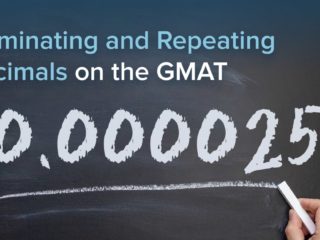Last Updated on May 3, 2023
GMAT OFFICIAL GUIDE PS
Solution:
We use the term “leading zeros” to describe the zeros between the decimal point and the first nonzero decimal digit. To complete this problem we can use the following rule to determine the number of leading zeros in a fraction when it is converted to a decimal:
If X is an integer with k digits, then 1/X will have k – 1 leading zeros unless X is a perfect power of 10, in which case there will be k – 2 leading zeros.
We see that t is in the form 1/X. Because the denominator X has more twos than fives, we know X is not a perfect power of 10. Before considering the fraction as a whole, we first must determine the number of digits in the denominator.
Rewriting the denominator, we get 2^9 x 5^3 = (2^6 x 2^3) x 5^3 = 2^6 x (2^3 x 5^3) = 64 x (1,000) = 64,000, which is a 5-digit integer. Thus, k = 5.
Using our rule, we see that the fraction t has 5 – 1 = 4 leading zeros.
Answer: B


